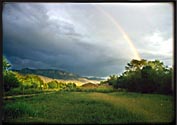If one were to take a large enough airplane engine with a propeller, and bolt it on to a barn door, it could be made to fly. This is the basic concept behind the average home design today. Through brute force, we use air conditioners and forced-air heaters to make our homes comfortable. It is done this way because the machines exist to heat and cool any building, of any design, in any climate. All it takes is a lot of gas and electricity to change the air temperature to our comfort level.
The problem is that all of this brute-force comfort comes at a high cost to both the homeowner and the environment. The homeowner must pay hundreds or thousands of dollars per year to make up for an energy-inefficient building design. The environment is stressed because of the pollution created from generating excess electricity, burning fossil fuels, and from the inefficient use of building materials.Energy performance is invisible to the average homeowner during the design stage. This is something that can be changed. We need simple, green building guidelines to follow so that building an energy and resource-efficient home does not turn into a complicated research project for the homeowner, architect, or builder.
Many green building elements cost nothing to implement, yet can have a dramatic effect at reducing heating and cooling bills. For example, by orienting your house in an east/west direction (with the long side facing south) along with a carefully designed roof overhang, it becomes much easier to heat your home with the warmth of the sun in the winter and keep it much cooler in the summer. By placing the majority of windows on the south side, the low winter sun will enter under the eaves of the roof, and add much needed heat to the home, and thus lower energy bills.In the summer, when the sun is high in the horizon, the direct sun will be prevented from entering the home, and thus keeping the interior cooler. By keeping west facing windows to a minimum, air conditioning loads can be greatly reduced. By making north windows smaller, less heat will be lost in the winter. These green building design parameters may add nothing to the construction cost.
Other guidelines may add some cost up front, while actually returning a net gain over the long run. For example, a compact fluorescent bulb may cost $14.00 per bulb, while an incandescent bulb costs 50 cents. If the bulbs were to burn 6 hours per day for 4.5 years, the incandescent bulb would be replaced 10 times and cost $21.90 in yearly electricity costs (based on 10 cents per kilowatt hour). The compact fluorescent bulb will last the entire 4.5 years and have an annual electrical cost of $5.91 for the same amount of lightoutput. The total cost for using the incandescent bulbs would be $103.55 while the compact fluorescent would cost $62.95. Even though the compact fluorescent bulb cost $14.00 up front, it actually saves the homeowner $40.60 over the life of the bulb
1. Now, where would you like to put your money? And why is it that the majority of home-owners still use the antiquated incandescant lightbulb?
With good green building design, and the proper use of materials, it is even possible to build a home in the high desert that does not need an air conditioning system. These homes actually exist today and I live in one of them. I know from first hand experience that conserving energy and resources through green design can actually improve your quality of living without sacrificing comfort. It is a win/win scenario.

Ted OwensSyncronos Design
If you enjoyed this post, subscribe to our feed
2 thoughts on “The Economics of Energy Efficiency <br>In Green Building Design”